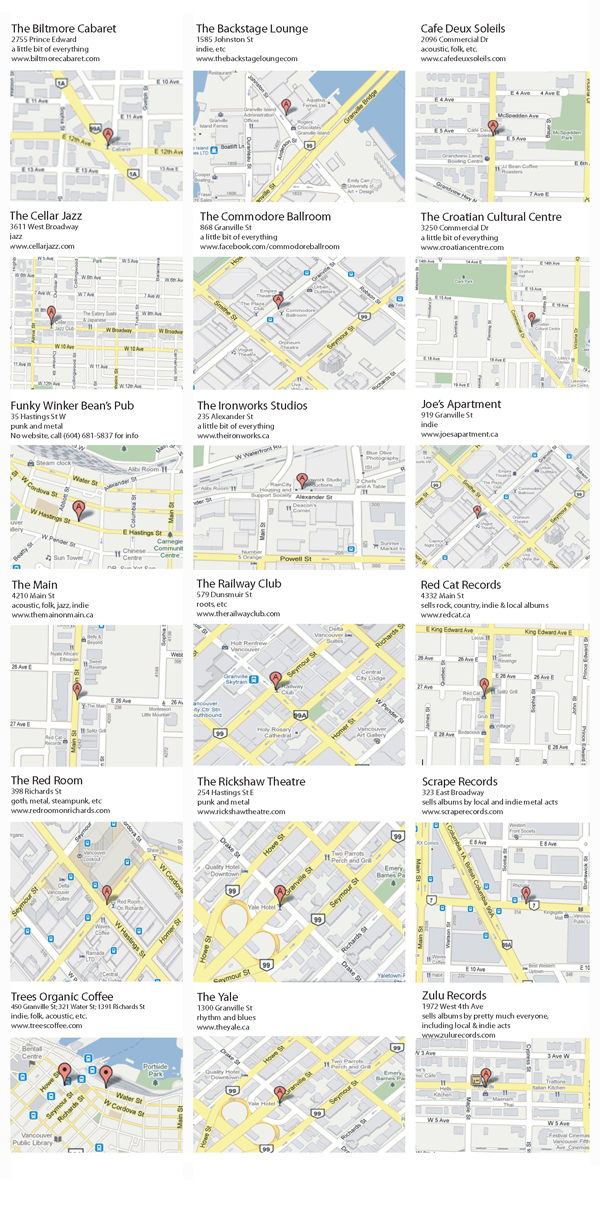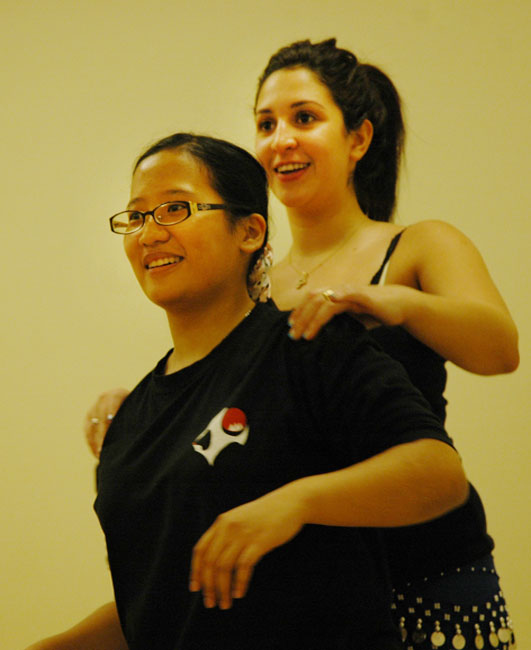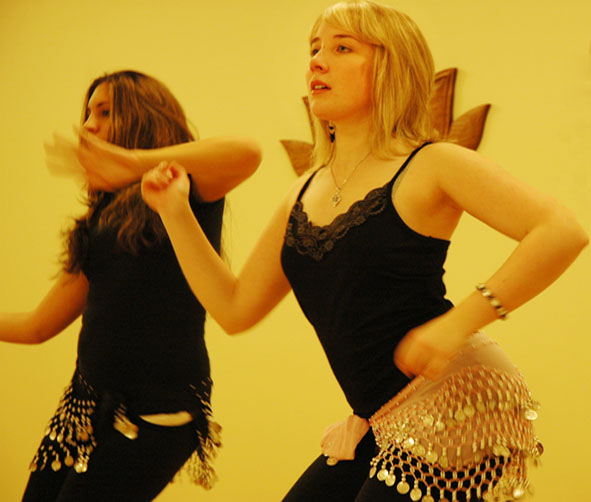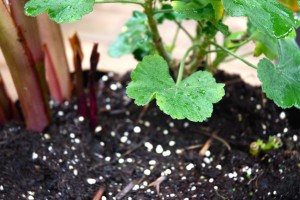Students surveyed over idea of a shorter semester
March 9, 2011 by Jocelyn Gollner · Leave a Comment
Do students want a shorter semester?
That’s the question that the Office of the Registrar at Kwantlen Polytechnic University is trying to answer.
Robert Hensley, registrar at Kwantlen, sent out an e-mail Feb. 21 asking for students to take a brief survey to determine whether they thought that the semester should be shortened by one week.
Currently, Kwantlen has three 15-week semesters a year (14 weeks of classes and one week of exams). The majority of other postsecondary institutions in B.C. have three 14-week semesters (13 weeks of classes and one week of exams).
Hensley could not be reached for a comment on the issue despite repeated tries.
A representative of the Kwantlen Student Association said that the KSA hasn’t taken a stance on the subject yet. However, she said that Brad Head, director of academics for the KSA, has reserached semester length, and found that people actually do better in shorter semester lengths.
“Some of us believe that it’s not that great, because you’re paying more per week of study essentially. But the short answer is that we don’t have an answer now. We have to develop policy and then council has to approve the policy before we can actually take a stance on something,” the KSA representative said.
The majority of students we talked to seem to be in favour of a shorter semester length.
“I agree with it,” Cisi Zhao, a Kwantlen business student, said. “I think it benefits students, because a lot of students want to go back to their hometown and if the breaks are too short, it’s not good for us.”
Justin Wong also wants a shorter semester.
“My friends that go to other schools are always done before us and it just feels like everyone else is already out there having fun and we’re still stuck in school. It just makes me not want to study,” he said.
Crystal Tang had a different idea about the subject.
She thought that a longer semester is more beneficial because then more detail can be explained in the course and instructors don’t need to rush through the curriculum.
.
Criminology club to make a comeback
March 9, 2011 by Jocelyn Gollner · Leave a Comment
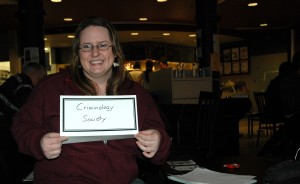
Leah Godin sits at Kwantlen's Club Night on March 3. She is in the process of starting up the Kwantlen Student Society.
Leah Godin, a third-year criminology student, is in the process of making the Criminology Student Society a reality again.
Up until last year, there was a Kwantlen Criminology Club, but according to Godin, the club dissolved after the club’s president graduated and no one took over the role.
Now Godin is encouraged and excited to bring it back to Kwantlen. But this time as a society, instead of a club. One of her instructors just thought it sounded better that way.
“I’ve announced it to a few of my classes, and I’m getting the instructors to tell their classes,” Godin said. “There are a bunch of people who are really excited about doing it, so it’s just the initial bit. You need to get so many people to sign up, which isn’t that much really, it’s only like 10 members.”
Godin had about 10 people sign up at the Kwantlen Club Night alone, which was on March 3 at the Grassroots Cafe.
The society will start out with a general meeting to see what students want from the society. Then, once it’s up and running, there will be field trips, talks given by instructors from Kwantlen and other post-secondary institutions, movie nights, pub nights, discussion groups, as well as information on how students can get involved in their community.
This club is open to all Kwantlen students, not just criminology students.
“I don’t want to cut anyone out of an opportunity because they might actually realize that they really like criminology and maybe later major in it,” Godin said.
It’s clear that Godin is passionate about starting up the Criminology Student Society.
“For some reason, this semester I’ve been getting really involved with what’s going on around campus,” Godin said. “The possibilities are endless, and I just feel that all Kwantlen students should be able to embrace what’s out there and what’s available.”
If you’re interested in joining the Criminology Student Society, email Godin.
Funny girl, and a busy girl, too
February 15, 2011 by Jocelyn Gollner · Leave a Comment

Nicole Passmore (left) and Kaitlin Fontana perform in their sketch group, Pony Hunters. (Photo courtesy of Kaitlin Fontana)
Kaitlin Fontana is a writer, sketch comedian, improv comedian and all-around funny girl.
And, after been involved with the comedy scene for roughly 10 years, she knows what she’s doing.
Fontana started out being involved in high school performances, and later was involved with UBC Improv. That lead her to doing comedy and improv with groups in both Vancouver and New York.
“I feel everyone needs something that allows them to explore their imagination and that creative part of themselves,” Fontana said. “I feel like comedy is that for me, particularly improvisation.”
She’s even started her own all female improv group, called Rosa Parks Improv.
“It started because I was surrounded by all of these awesome female improvisers and I wanted to take and perform on our own somewhere, just for kind of a different vibe. When all women are doing something, it changes things,” Fontana said.
Fontana has also formed a sketch group called Pony Hunters with one of the members of Rosa Parks Improv, Nicole Passmore, called Pony Hunters. A lot of their comedy is Star Trek-related, as how both Fontana and Passmore are big fans.

“I guess I would describe [my sense of humour] as nerdy and intelligent with a healthy dose of the ridiculous,” Fontana said. “I’m a nerd who reads a lot, so that comes out in my improv, for sure.”
Although Fontana is involved with many different forms of comedy, improv is where her heart is.
“The feeling of doing a really good improv show is very satisfying because, while I enjoy scripted work, and when it goes well I’m very happy with it, there’s a sense that it was programmed to succeed,” Fontana said. “Improvisation is much more risky. You don’t know what’s going to happen on stage. It’s not just you. It depends on the entire group of people you are performing with. It depends on trust and the energy in the room. And that undefinable other thing that makes comedy good, or makes any art good, that we can never really put our finger on. It’s like that magical ingredient.”
Fontana is busy with several comedy and improv shows coming up. Pony Hunters will be featured at an upcoming art exhibition about comedy at the Helen Pitt Gallery, where they will be showing the first episode of one of their web series, called Shitty Spock.
“It’s about a shitty version of Spock coming to Earth and trying to rescue his captain, and has found that his captain has become a mid-20s female, who lives on Earth and doesn’t realize that she is the captain. So basically it’s an odd couple comedy,” Fontana said.
She’s also performing on Feb. 17 at The China Cloud in Chinatown with Ghost Jail Theatre, an improv and spontaneous writing group.
Then, from Feb. 23-26, she’ll be performing at the CBC Studio 700, with a bunch of other improv groups from around the city.
“Someone once said that it takes 10 years to be good at anything. I feel like I’m starting to get to that point where I feel very comfortable in [improv] and I like to explore it, teach it and direct, as well as perform. And it’s like anything. I mean why does a painter paint? The motivation is that creative impulse.”
The art of bonsai guitar making
February 6, 2011 by Jocelyn Gollner · 1 Comment
There’s no doubt Cal Thompson is an original.
Wearing rolled-up jeans and an I Heart NYC t-shirt, he fits the description of laid-back musician. But there’s something different about him: he makes bonsai guitars.
Bonsai guitar is a name he has given to the instruments that he makes, which look like regular-sized guitars, but miniatures. Thompson estimates that he has made over 400 bonsai guitars.
Some of these instruments can be found hanging from hooks on the wall in his apartment, running the entire length of the main wall. Other guitars are or have been in the hands of famous musicians, ranging from Link Wray to Paul Hyde.
Asked who the majority of his customers are, he says that he gives most of them away to children.
“I really don’t care all that much about money, much to the chagrin of my wife and everyone else around me.”
His band, Little Guitar Army, also performs with many of his bonsai guitars.
Thompson said that the sound from a bonsai guitar, in comparison to a regular-sized guitar, is “a little bit higher, but on all of my records, no one can tell they’re not full-sized guitars until they see us play live.”
[audio: bonsai.mp3]
Click to hear Thompson play one of his bonsai guitars
The History
When Thompson was seven or eight years old, his uncle gave him a guitar.

A Motorhead VIP pass is shown on one of the bonsai guitars. Many members of the band Motorhead have Thompson's guitars. (Photo by Meagan Gill)
“I immediately knew that that was it. That was my first love, my first marriage. I’ve devoted myself to it, regardless of what anyone thinks, tells me or feels,” he said.
Apart from loving the music itself, he also became interested in the mechanics of guitar building. He had grown up around his father’s cabinet shop doing woodworking, so he learned some of his skills from there.
“I started doing it when I was really young,” Thompson said. “I think I came across a ukelele and decided that I could put the same things that were on a big guitar on a little guitar.”
Years later, he was taught instrumental construction by Michael Dunn, a guitar builder from Vancouver, who taught at Douglas College. Dunn says that Thompson was a good student.
“The proof is that he’s still out there making instruments. It wasn’t for everyone. It’s not an easy thing to do. It’s tough,” Dunn said.
Thompson also worked for Jean Larrivee, another well-respected guitar builder in Vancouver. It was there that he had the idea of making bonsai guitars from materials that people were throwing away.
Larrivee “was throwing stuff out and I thought there was so much waste. So I started taking everything that he was throwing out and taking it home. I built a lot of instruments on what people were throwing out.”
Even now, each time he needs materials for a guitar, he’ll scavenge alleys and trash bins in an attempt to find something usable. Thompson said that thriftiness runs in his family.
“My grandfather was a real handy fellow. He didn’t have much money and he had all these responsibilities. So if he needed something, he would come up with something or just do without…My father is the same way.”
About 90 per cent of the materials he uses to build his guitars have been thrown out by somebody.
The Process
His building process starts with a design. He’ll sit at his wooden kitchen table and sketching. Once he has something that he likes, he doesn’t mess around with the design much anymore.
“I’m pretty much done when I know that something is right,” Thompson said.
Next he’ll use math to figure out things like the scale length and how far apart the frets are going to be on the guitar. Then he collects his materials.
Once Thompson has designed, planned and gotten his materials, the building begins.
“I have a checklist in my head that I do. So I’ll make the bodies and make sure that they’re fine. Then I’ll make the necks. And I’ll marry the necks to the bodies. I make sure that they are going to function sonically and be comfortable.”
After that, he worries about the esthetics of the guitar.
“I worry about how they sound and how they feel,” Thompson said. “They can sound really good but if they are uncomfortable to play, then no one is going to make good sound on them.”
The time it takes for him to make a bonsai guitar varies. He has built one in as little as a day and a half, but he has yet to finish a guitar he started building in 1988.
It costs Thompson roughly $600 to make a guitar, but says that some of the guitars that he makes are worth upwards of $3,000.
Thompson has made hundreds of guitars, but he doesn’t feel like he has perfected his craft.
“If I come out with something that is even close to the essence of what I had in my head, I’m satisfied with it,” he said. “And the older I get, the closer I get. It’s never been perfect, and I doubt it ever will, but the older I get, the closer it gets.”
Each guitar is precious to him. Ask him which is his favourite guitar, and he’ll look shocked.
“It’s like asking what one of your children is your favourite! Yeah, probably deep down in my psyche I do [have a favourite], but I’ll never tell a soul. I’d probably feel guilty about it.”

A portion of the bonsai guitars at Thompson's apartment are displayed on one of the walls. (Photo by Meagan Gill)
What now?
“It’s a compulsion more than I’d like to say,” he said. “When I can make a living out of it, I do. But it’s kind of hard to make money out of being an artist.”
He has supported his art by maintaining a variety of other jobs, including carpentry and cabinet-making. Right now, he is thinking about working in a local guitar factory and a guitar repair shop up the street from his house.
But don’t expect to find him playing or crafting full-sized guitars anytime soon.
“Why do someone else’s thing, when I can do my own thing?” he asks. “It’s a hard road, mind you. If you do something that differs, in any culture or subculture, I find that people want you to conform. And if you don’t, my god. You will be called all sorts of names and you’ll find all sorts of barriers that are put up by people trying to be individuals. It’s really quite hard. It’s not easy.”
But continue he will; it’s his love.
Social media changes funding, distribution for indie filmmakers
January 30, 2011 by Jocelyn Gollner · 1 Comment
Social media is changing the way that we do almost everything and that now includes how independent filmmakers are funding and distributing their films.
“Everything is changing so quickly that 10 years from now, we won’t even recognize what it is right now,” said Ryan Catherwood, an independent filmmaker from Vancouver.

IndieGoGo is one site that filmmakers are using to help get funding for their films.
Besides the obvious social media forms, such as Facebook and Twitter, there are also specialty sites such as IndieGoGo that filmmakers are using for their films. IndieGoGo defines itself as an international funding platform.
Catherwood has recently starting using IndieGoGo and said that it’s a different way to raise funds for a film.
You “basically just put a pitch up online and then cross your fingers that people want to invest in it and become a part of it,” he said. Anyone can create an account, and attempt to raise funds for almost anything.
This money can make a huge difference to independent filmmakers.
“I work at a rental shop and, like a lot of my friends, we’re all filmmakers and we want to spend our time and our energy and our passion in film, but we have to get supplementary jobs to afford that,” Catherwood said.
Funding a film isn’t the only problem; distributing that film is also sometimes an obstacle.
“Distribution is continually becoming a problem, besides just putting it up for free online,” Catherwood said. “There are not a lot of options for filmmakers these days. It’s kind of like the elephant in the room that no one wants to talk about right now, but I keep trying to bring it up and just say like we have to find a way to make money from our films.”
As much as social media can help filmmakers distribute their films, it also poses its own set of problems.
“YouTube came along and it’s kind of the Coca-Cola of Internet broadcasting. It’s hard to get an edge on them,” Catherwood said.
Amid all the changes, Catherwood doesn’t know what the future holds.
“I don’t know where the independents are going to end up,” he said. “Until the independents, like one of our own, creates something to distribute indie films on a larger scale, nothing is going to change. That’s kind of how I see it.”
What is Indie?
January 17, 2011 by Jocelyn Gollner · Leave a Comment
Where to find indie music in Vancouver (article below graphic):
Infographic by Amanda Punshon
We’ve heard about indie music, indie films, and other indie arts.
But what exactly does it mean?
It’s more than guys in tight jeans who listen to bands that no one has ever heard of.
Oswaldo Perez Cabrera is involved with the promotion and public relations for VanMusic.ca, a Vancouver-based website dedicated to giving exposure to indie bands.
He defines indie as being “all forms of art or culture that are outside of the mainstream media.”
Kwantlen students at the Richmond campus were also asked how they would describe indie, specifically indie music.
“Hmmm, that’s a good question,” said Alexandra Pastega, an English and marketing student. “Slightly acoustic. It has a kind of soft punk vibe to it in my opinion. Indie bands to me would constitute a band maybe like Metric. Kind of edgy but soft.”
Ian Nobak, a general studies student, said that indie means “independent. It would be maybe students making music, like downloading software and mixing it themselves.”
There is quite a difference, however, between a band such as Metric, which gets played on the radio, tours worldwide and has a large fan base, and students mixing music in their basement.
“There are people that start as indie and they move into more established companies,” Cabrera said. “There are other bands that prefer to keep it indie. Even some indie record companies, some indie labels, that start with a couple of bands, with their friends, and they become bigger and bigger. So then we have this question of how big they have to be to still be considered indie?”
It’s a question with no definitive answer. Everyone seems to have his or her own opinion.
But small or big, Cabrera believes that having independent artists is an important aspect to any city.
“Since [indie artists] don’t have any censorship or they aren’t subjected to what big companies are going to decide for them, it’s a very important voice to the culture of any city. It shows a little bit what the problems are in the city, it talks a bit about social issues, a lot of the time about environmental issues, they talk about what is happening in the subcultures of the city.”
He also believes that indie music is a form of resistance.
“It’s a resistance against the whole establishment. Because right now, most of radio and television, they tell you what to listen to, they tell you what to buy, they tell you how to think. And all these indie artists, it’s a resistance to all of that. Because they are talking about different things. They are talking about things that are contrary to what the establishment or what the mainstream is telling you to do. That’s a form of resistance.”
Winter driving: keeping it safe
December 11, 2010 by Jocelyn Gollner · Leave a Comment
It’ time again for snowy roads, icy streets and frosty windshields.
For many Vancouverites, driving in winter conditions is not something that comes naturally, mainly because they haven’t had much practice.
>
BCAA, the British Columbia Automobile Association, has some tips on staying safe while driving this winter season.
First, if you are going to be driving in the snow, you should have snow tires. Make sure that they are all the same brand and make of tires as well, in order to get optimal performance from your vehicle.
Before you begin to drive, make sure that you have complete visibility. This means scraping ice off windows and de-fogging all of them.
Also, clear all snow off of your car before beginning to drive. Snow falling onto your windshield while you are driving can be dangerous if it blocks your vision.
During winter, windshields get dirtier from all of the dirt and debris on the roads. Keep your windshield washer fluid reservoir filled and get new windshield blades if the current ones are leaving streaks.
A useful tip is to not keep your rear-window defrost and heater on when not needed. They will gradually drain your car’s battery, and can actually cause it to die if the battery is already low and the car is idling.
When you start driving in the snow or on icy roads, be careful.
It may sound obvious, but do not drive your car faster than you can control it.
Also, be considerate of the other drivers around you. Let other drivers know when you are going to be changing lanes by signaling in advance, increase the space between you and the car in front of you, and brake gradually when coming to a stop.
If you are driving a standard transmission car, downshift to slow down rather than braking.
And if the roads are looking really ugly and hazardous, don’t drive if you don’t need to.
A full list of driving tips and winter car maintenance can be found at the BCAA website.
Passion for Dancin’
November 21, 2010 by Jocelyn Gollner · Leave a Comment
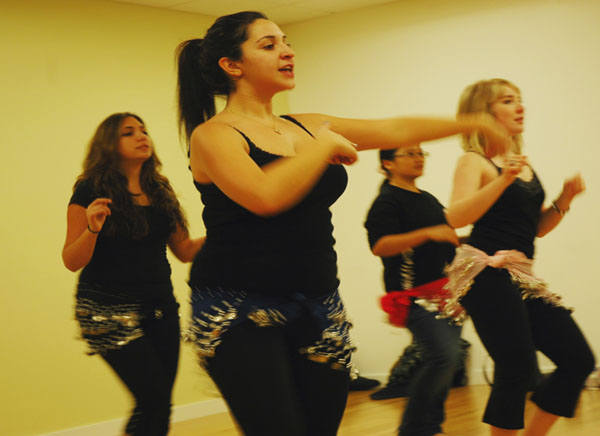
Meirna Said teaches the Passion for Dancin' club at the Richmond campus on Thursday. (Photo by Meagan Gill)
Kwantlen students are showing they have a Passion for Dancin’.
Passion for Dancin’ is a new club at Kwantlen that allows students who like to dance the opportunity to learn a variety of cultural dances, including bellydancing, salsa, bachata and merengue.
Meirna Said created the club only about a month ago, although she has been seriously thinking about it since last year.
“What I got from [the club members] is that they wanted a workout and learning how to dance, and that’s what I want to give them. I want to give them fun, enjoyment and learning with it,” Said said.
The Dance Towards Peace Organization, which Said represents, was what inspired her to start the club. The organization “tries to promote peace through dancing. And especially through children. So we used to try to teach children how to dance. We used to go to the cancer hospitals…and teach them how to dance. And we found out it was great because with dancing you can do anything,” Said said.
Next week, club members will be learning how to dance salsa and they’ll be going to a salsa night somewhere in town during the week, to see first-hand what salsa dancing is like.
The club meets every Thursday night from 7 to 8 p.m. at the yoga studio on the Richmond campus. A fee of $30 is charged for the club for the whole semester, and goes towards the Breast Cancer society.
Green Wednesday back at Langley this week
November 8, 2010 by Jocelyn Gollner · Leave a Comment
Another round of Green Wednesdays at Kwantlen is almost here.
This Wednesday, the School of Horticulture and the Green Ideas Network will be showing “Dirt: The Movie” at the Langley Kwantlen campus.
Gary Jones, Horticulture Instructor at Kwantlen, says, “It’s really a time for some informal education around issues of sustainability and it provides a venue for people to come together to discuss these things in a very informal setting.”
Typically, a Green Wednesday begins with an environmentally-themed movie. Then there is a break, where people can have something to eat and drink, before door prizes are awarded. The door prizes are from the event’s sponsors: A Bread Affair and Ladybug Organics.
The rest of the evening is left open for when there is a guest speaker, such as last month when the movie makers of “The Clean Bin Project” arrived to talk and answer questions at the event.
“We try to have some take-home action points as to what we can do in terms of personally at home or in our individual communities to make some changes,” Jones said.
An average of somewhere between 50 and 60 people attend the monthly Green Wednesdays, but Jones said that this number is steadily increasing.
“At the last event, which was the first of the season, we had 130 people,” Jones said.
This Wednesday, as well as showing the short 40-minute film “Dirt: The Movie,” some of the movie’s special features will be shown.
“I want to show two of them in particular,” Jones said. “One is about landscape planning and town planning, and how that effects soil and how that affects community. And the other one is about schools and bringing education around soil, food production, sustainability and food security into the classroom.
“I’d like people to go away with something that they can actually think about doing.”
Green Wednesdays are held at the Langley Kwantlen campus in Room 1325, with doors opening at 6:30 p.m. and the movie starting at 7. Admission is by donation.
Video: Who pays when you’re on a date?
November 8, 2010 by Jocelyn Gollner · Leave a Comment
Jocelyn Gollner, Miranda Gathercole and Sarah Casimong explore what Kwantlen students think about traditional gender roles in dating. Students voice their opinion about what they think about the expectation of guys having to pay on dates and whether it’s out of a woman’s place to be forward.



